Summary Overview
Ibuprofen Market Overview
The global ibuprofen market is steadily expanding, driven by rising demand in industries such as healthcare, pharmaceuticals, and consumer wellbeing. This market includes various kinds of ibuprofen products, such as pills, capsules, liquid formulations, and topical creams. Our paper provides a detailed examination of market trends, with an emphasis on cost-effective methods and the use of new approaches for enhancing distribution and consumer access.
Key challenges for the ibuprofen market include controlling production costs, guaranteeing consistent product quality, resolving regulatory compliance, and maintaining strong supply networks. Digital technologies and data-driven insights are becoming more crucial for optimizing manufacturing processes and streamlining distribution systems. As global demand climbs, businesses are using market data to improve operational efficiency, mitigate risks, and remain competitive in an ever-changing market.
Market Size: The global Ibuprofen market is projected to reach USD 5.4 billion by 2035, growing at a CAGR of approximately 4.2% from 2025 to 2035.
Growth Rate: 4.2%
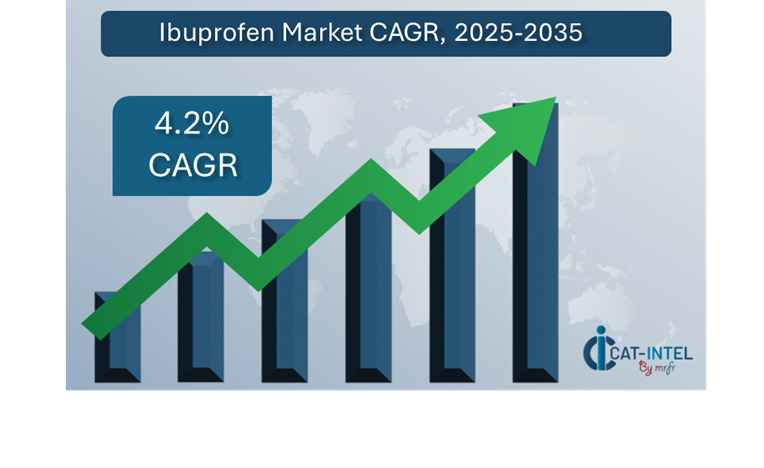
-
Sector Contributions: Growth in the market is driven by: -
Manufacturing and Supply Chain Optimization: There is an increasing demand for real-time data and seamless integration across production processes to streamline operations and improve efficiency in ibuprofen manufacturing.
-
Retail and E-Commerce Growth: The proliferation of online pharmacies and e-commerce platforms has resulted in the adoption of advanced inventory management systems and improved customer relationship management (CRM).
-
Technological Transformation: Advances in AI and machine learning are driving innovation in ibuprofen manufacturing and distribution, allowing predictive analytics and process automation to improve operational efficiency.
-
Innovations: New formulas and packaging, such as the invention of modular ibuprofen solutions that cater to specific consumer needs, are reducing production complexity and driving cost-effectiveness.
-
Investment Initiatives: Businesses are rapidly investing in cloud-based solutions to streamline operations, decrease infrastructure costs, and enable remote access to critical data and resources.
-
Regional Insights: North America and Asia-Pacific remain major markets, benefiting from strong healthcare infrastructure and increased consumer demand for over-the-counter pain relievers.
Key Trends and Sustainability Outlook:
- Cloud Integration: The expanding use of cloud-based solutions improves the scalability and cost-efficiency of ibuprofen production and distribution, providing businesses across the value chain with better access to vital data and insights.
- Advanced Features: The combination of AI, IoT, and blockchain technology is increasing transparency in the supply chain and enhancing decision-making by allowing for improved tracking and traceability of medicinal goods.
- Focus on Sustainability: Companies are using sustainable methods in ibuprofen production, with an emphasis on eco-friendly sourcing, waste minimization, and improving the environmental impact of manufacturing processes.
- Customization Trends: There is an increasing need for bespoke ibuprofen, manufacturers and retailers can use sector to estimate demand trends, optimize inventory management, and track product performance across regions
Growth Drivers
-
Digital Transformation: The growing use of digital tools and technologies throughout the ibuprofen supply chain, from manufacture to distribution, is raising overall productivity.
-
Demand for Process Automation: As ibuprofen production processes become more automated, organizations can decrease operational bottlenecks, improve uniformity, and increase scalability.
-
Scalability Requirements: As organizations grow, there is a strong demand for scalable production systems and distribution networks that can meet increased demand and different market requirements.
-
Regulatory Compliance: Ibuprofen producers use technology to meet demanding regulatory standards, including as quality control, labelling, and reporting, assuring safe and effective goods.
-
Globalization: As Need for Ibuprofen continues to expand globally, businesses are looking for solutions that support multi-region distribution, currency and language requirements, and compliance with international healthcare legislation.
Overview of Market Intelligence Services for the Ibuprofen Market
Recent investigations have revealed numerous significant problems in the ibuprofen industry, including increased production costs and the necessity for product modification to fulfil various consumer preferences. Market intelligence studies provide meaningful insights into procurement prospects, assisting businesses in identifying cost-saving measures, optimizing supplier relationships, and ensuring the effective adoption of new goods. These insights also help to ensure regulatory compliance, high-quality manufacturing methods, and effective cost management across the supply chain.
Procurement Intelligence for Ibuprofen: Category Management and Strategic Sourcing
Businesses in the ibuprofen industry are streamlining their procurement procedures by concentrating on spend analysis and vendor performance tracking. Effective category leadership and strategic sourcing are critical for reducing procurement costs while maintaining a regular supply of high-quality raw materials and packaging solutions for ibuprofen manufacture. Manufacturers may improve their procurement strategy, negotiate better terms with suppliers, and assure the ongoing availability of high-quality ingredients and resources for their ibuprofen products by accessing precise market knowledge. This method helps to preserve profitability while being competitive in a continually changing industry.
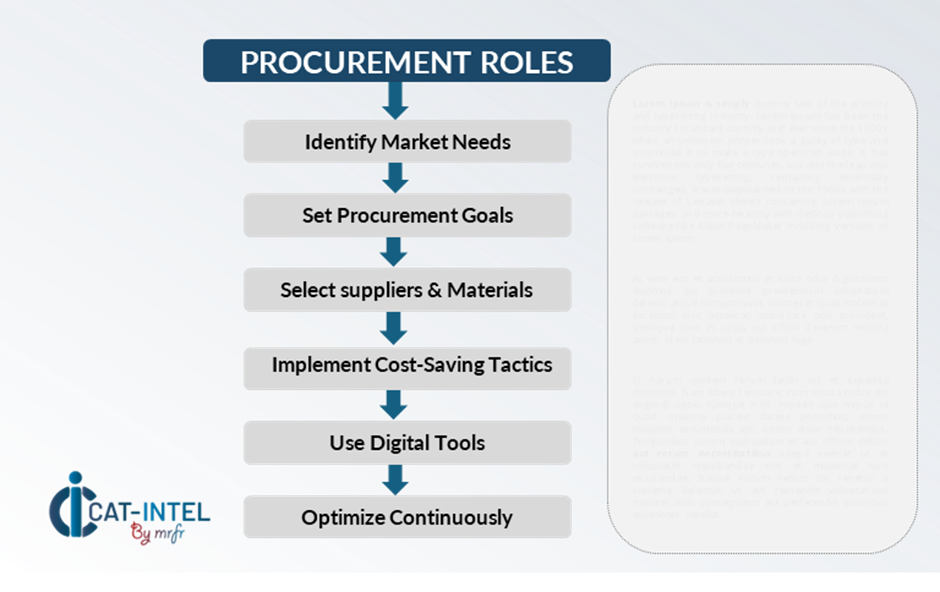
Pricing Outlook for Ibuprofen: Spend Analysis
The pricing prognosis for ibuprofen production is projected to be moderately volatile, impacted by a variety of variables including advances in manufacturing technology, demand for eco-friendly packaging options, and fluctuating raw material costs. Key drivers include the increased usage of digital technologies for process optimization, the need for more efficient manufacturing methods, and regional pricing variations in the procurement of ingredients like ibuprofen's active pharmaceutical ingredient (API).
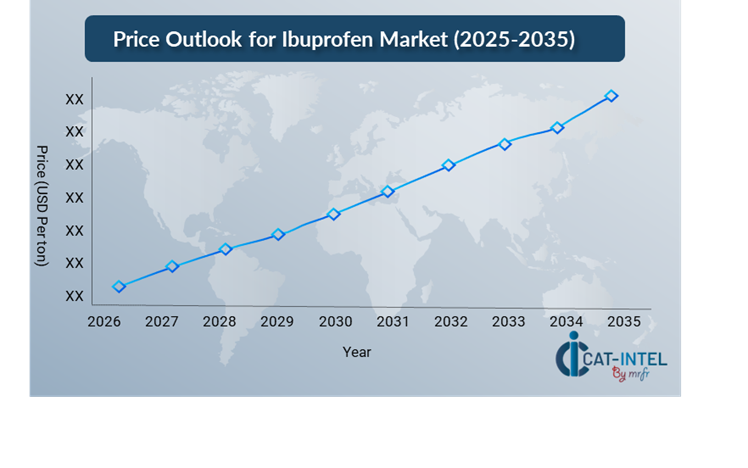
Efforts to optimize procurement procedures, improve supplier management, and implement flexible manufacturing models are critical for cost control. Using digital tools for market monitoring, demand forecasting via analytics, and efficient supplier relationship management can help to improve cost efficiency in the ibuprofen industry.
Partnering with dependable raw material suppliers, negotiating long-term contracts, and investigating pricing models based on volume or regional market conditions are all critical techniques for effectively managing production costs. Despite these obstacles, focusing on scalability, assuring quality control, and implementing sustainable production processes will be crucial to preserving cost-effectiveness and operational excellence in the ibuprofen industry.
Cost Breakdown for Ibuprofen: Total Cost of Ownership (TCO) and Cost-Saving Opportunities
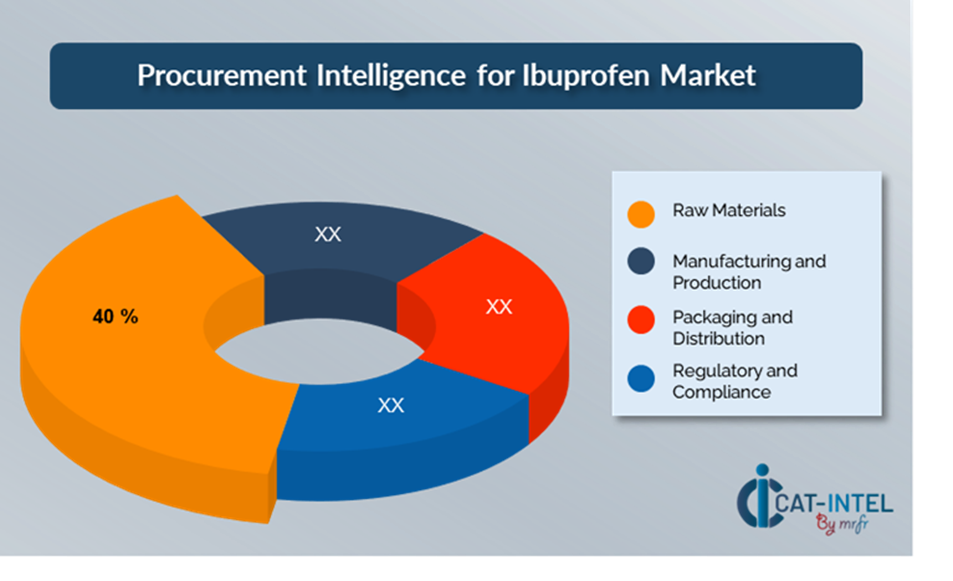
-
Raw Material: (40%)
-
Description: The key cost driver here is the cost of active pharmaceutical ingredients (API), which are obtained from chemical suppliers. Raw material prices fluctuate owing to supply chain disruptions, regulatory changes, or sourcing issues.
-
Trend Point: Companies are looking for ways to save costs by establishing long-term supplier contracts or investing in biotechnology and more efficient manufacturing procedures.
-
Manufacturing and Production: (XX%)
-
Packaging and Distribution: (XX%)
-
Regulatory and Compliance: (XX%)
Cost-Saving Opportunities: Negotiation Levers and Purchasing Negotiation Strategies
In the ibuprofen manufacturing business, streamlining procurement processes and implementing effective negotiation methods can result in significant cost savings and increased operational efficiency. Setting up lengthy contracts with raw material suppliers, particularly those who provide high-quality active pharmaceutical ingredients (APIs) and packaging materials, can lead to more favourable price structures and terms, such as volume discounts, long-term supply assurances, and bundled service packages. Flexible pricing structures and multi-year contracts with suppliers allow firms to get lower rates, safeguard against price changes, and reduce cost increases over time.
Collaborating with suppliers who prioritize innovation and scalability also provides benefits, such as access to new production technologies, sustainable sourcing methods, and bespoke product formulations, which can help lower long-term operational costs. Implementing digital procurement technologies like as contract oversight platforms, demand projection software, and vendor efficiency analytics increases transparency, provides more precise inventory management, and reduces overstocking and understocking.
Supply and Demand Overview for Ibuprofen: Demand-Supply Dynamics and Buyer Intelligence for Effective Supplier Relationship Management (SRM)
The ibuprofen market is steadily expanding, driven by rising consumer demand, technological developments in manufacturing, and a growing emphasis on health and wellbeing. Supply and demand dynamics in this industry are influenced by raw material availability, production technology, regulatory requirements, and global economic situations.
Demand Factors:
-
Consumer Health Trends: As people become more aware of self-care and pain management, demand for over-the-counter ibuprofen medications is increasing, particularly in older populations.
-
E-commerce Growth: The proliferation of online pharmacies and direct-to-consumer sales is driving rising demand for ibuprofen in digital marketplaces, necessitating effective distribution and logistics techniques.
-
Regulatory Compliance: Demand for ibuprofen formulations customized to specific health needs (e.g., children, elders) is rising, owing to regulatory criteria in various locations.
-
Packaging and Convenience: The growing demand for convenient ibuprofen formats, including as liquid gels, blister packs, and multi-dose bottles, reflects consumer preferences for simple and portable products.
Supply Factors:
-
Technological Advancements: Innovations in drug formulation, manufacturing techniques, and packaging technologies are improving ibuprofen production efficiency and lowering costs.
-
Raw Material Supply: The availability and cost of important ingredients, such as ibuprofen API, as well as packaging materials like plastics and aluminium, have an impact on price and supply chain stability.
-
Global Economic Factors: Exchange rates, labour costs, and regional inequalities in healthcare infrastructure all have an impact on the price and availability of ibuprofen in different regions.
-
Scalability and Flexibility: Modern manufacturing processes, including modular production systems and flexible supply chains, enable providers to fulfil shifting needs for ibuprofen.
Regional Demand-Supply Outlook: Ibuprofen

North America: Dominance in the Ibuprofen Market
North America, particularly the United States, is a dominant force in the global Ibuprofen market due to several key factors:
-
High Disposable Income: North American consumers have higher disposable incomes, which allows them to spend more on health-related products like ibuprofen.
-
Regulatory Environment: North America has strict regulatory procedures, including approval from organizations such as the FDA, to guarantee that ibuprofen products satisfy high safety and quality standards.
-
E-Commerce and Retail Access: Consumers in North America are increasingly preferring the ease of obtaining ibuprofen online, driving up market demand.
-
High Consumer Awareness: North America has a high prevalence of chronic pain problems including arthritis and back pain, which increases demand for over-the-counter pain relievers like ibuprofen.
-
Strong Healthcare Infrastructure: North America has a well-developed healthcare system and modern pharmaceutical infrastructure. Availability of healthcare professionals to advise on pain management further supports market growth.
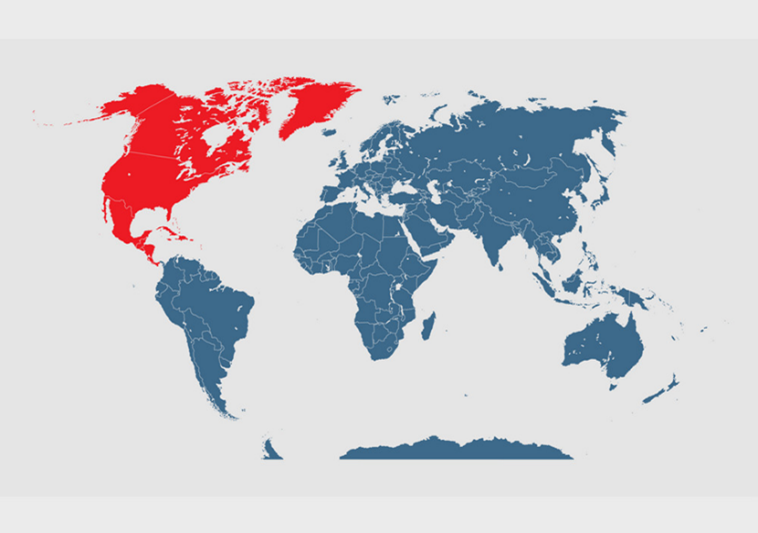
Supplier Landscape: Supplier Negotiations and Strategies
The ibuprofen market supplier landscape is also diversified and fiercely competitive, with global pharmaceutical behemoths and regional or minor businesses influencing industry dynamics. These vendors have an impact on critical elements such as manufacturing costs, raw material procurement, product formulation, and packaging. Large, well-established pharmaceutical corporations dominate the market, offering a diverse range of ibuprofen products, while smaller, specialist manufacturers focus on specific product variants or distinctive features, such as eco-friendly packaging or formulas customized to specific populations.
The ibuprofen supplier ecosystem includes both global and regional players, each catering to unique market needs. Global suppliers advantage over economies of scale, broad distribution networks, and comprehensive regulatory compliance frameworks, whereas smaller companies frequently emphasize customized solutions, shorter lead times, and specialized product offerings to meet regional consumer demands. As the market expands, ibuprofen manufacturers are looking into new manufacturing techniques, extending product lines, and employing digital tools to streamline supply chains.
Key Suppliers in the Ibuprofen Market Include:
- Pfizer Inc.
- Johnson & Johnson
- GlaxoSmithKline (GSK)
- Bayer AG
- Sanofi
- AbbVie Inc.
- Mylan N.V.
- Novartis AG
- Reckitt Benckiser
- Amgen

Key Developments Procurement Category Significant Development
Significant Development |
Description |
Market Growth |
The ibuprofen market is expanding rapidly, driven by rising consumer demand for pain treatment products, a greater emphasis on health and wellbeing, and more availability to over-the-counter drugs. |
Cloud Adoption |
In the ibuprofen production and distribution sectors, there is a rising tendency toward digital solutions, with cloud-based technologies enabling improved supply chain management, inventory control, and prediction of demand. |
Product Innovation |
Ibuprofen makers are innovating by creating new product formats and formulations, such as extended-release variants, liquid gels, and targeted-dose options. Some organizations are also looking into AI-powered analytics to estimate market demand and streamline inventory management.
|
Technological Advancements |
The integration of IoT devices into the supply chain enables real-time tracking of raw materials, production schedules, and product delivery, resulting in more efficient operations and increased product availability. |
Global Trade Dynamics |
Changes in global trade restrictions, compliance standards, and economic policies are affecting the distribution and availability of ibuprofen products across areas. |
Customization Trends |
Manufacturers are reacting by developing tailored solutions to fit regional, cultural, or health-specific needs, giving consumers greater flexibility in how they buy and use ibuprofen. |
|
Ibuprofen Attribute/Metric |
Details |
Market Sizing |
The global Ibuprofen market is projected to reach USD 5.4 billion by 2035, growing at a CAGR of approximately 4.2% from 2025 to 2035. |
Ibuprofen Technology Adoption Rate |
Around 70% of global consumers take ibuprofen for pain relief, with an increasing preference for over-the-counter pain relievers. |
Top Ibuprofen Industry Strategies for 2025 |
Product innovation for targeted relief, extending eco-friendly packaging options, growing online sales channels, and focusing on regulatory compliance to expand the market are all key strategies. |
Ibuprofen Process Automation |
Approximately 55% of the ibuprofen manufacturing plants use automation in processes like tablet coating, packaging, and quality control to boost efficiency.
|
Ibuprofen Process Challenges |
Fluctuating raw material costs, supply chain interruptions, regulatory compliance, and consistent product quality are all significant issues. |
Key Suppliers |
Pfizer Inc. (USA), Johnson & Johnson (USA), and GlaxoSmithKline (UK) are among the leading ibuprofen suppliers, each of which offers a variety of ibuprofen medications in different formulations. |
Key Regions Covered |
North America, Europe, and Asia-Pacific are the most popular regions for ibuprofen use, with North America leading the way due to aging demographics and increased health awareness. |
Market Drivers and Trends |
Increased consumer knowledge of pain management, expanded e-commerce in healthcare, a growing emphasis on self-care, and product formulation advances are all driving growth. |

